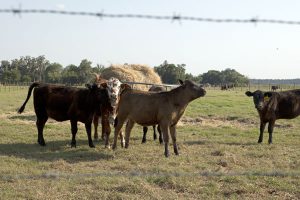
Winter pastures of small grains and ryegrass are some of the most nutritious forages grown in Florida. Beef Cattle perform very well on the high protein and energy rich forage.
This added nutrition gives a real boost to overwintering cattle. However, those same high levels of protein coupled with high potassium levels and low magnesium levels can cause a disorder in cattle called grass tetany.
Grass tetany is also called grass staggers or hypomagnesia, meaning that blood levels of magnesium drop to dangerously low levels. Cows that are nursing calves are most commonly affected by the disorder.
The symptoms of grass tetany include nervousness, lack of coordination, muscular spasms, staggering and death. When the disease is suspected, a veterinarian should be called immediately to diagnose and to initiate treatment. However, in beef herds, the herdsman does not always have the opportunity to observe the signs of the disease and affected cattle may simply be found dead in the pasture.
Use of dolomitic limestone (dolomite), which contains magnesium, to increase forage magnesium helps reduce the risk of grass tetany. If no lime is needed on soils with an already high pH level, magnesium oxide can be included with fertilizer materials. Excess nitrogen in conjunction with high levels of potassium fertilization tends to reduce the magnesium level in the forage. Consequently, these fertilizer elements should not be applied in excess on small grains or ryegrass winter pastures. Follow recommendations based on soil test results.
In spite of the risk of this disorder, the benefits of grazing high quality winter pastures offsets the dangers if some management practices are followed:
Feed mineral supplements that contain magnesium. Commercial mineral mixtures containing 10–15% magnesium are available for feeding during periods of increased grass tetany probability. Cattle need to consume 6–12 oz./head/day of this mineral.
In herds that have had previous grass tetany problems, increase the supplementation to ½ to 1 oz. of MgO per cow per day from 2 weeks before grazing winter pasture or the start of calving until winter pastures are more mature and the grass tetany risk is reduced.
In herds where there are clinical cases of grass tetany, increase the Mg intake to 1–2 oz. per head daily and continue this amount until the high risk pasture grazing period is past.
Feed high magnesium minerals in mineral feeders placed at convenient locations around the pasture. Move mineral feeders closer to watering and resting areas if mineral consumption is low.
Check the calcium (C) to phosphorus (P) ratio (2:1 is optimum), and energy intake (maintenance or above is desired) of the animal. Grass tetany may be less likely to occur when these factors are near optimum.
Remove animals from pasture or limit grazing during periods of rapid growth. Allow access to hay or dry pasture. Also, producers may want to limit grazing of the temporary winter pastures when moving cattle directly from poor quality frosted grass pastures. A rapid change in feed can cause digestive upsets and nutritional stress.
Fertilization suggestions: On soils that need liming, use dolomitic limestone. If lime is not needed, magnesium can be included in mixed fertilizers. Do not exceed the recommended level of applications for nitrogen and potassium on winter pastures for grazing.
If you have any pasture or livestock questions, please feel free to contact Ed Jennings, UF/IFAS Extension Director for Levy County at (352) 486-5131 or by email at edjennin@ufl.edu.
 0
0

Comments are closed.